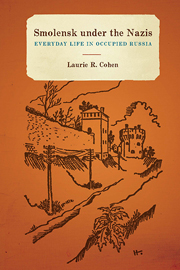Book contents
- Frontmatter
- Contents
- Acknowledgments
- Abbreviations
- Introduction
- Part 1 Methodologies
- Part 2 A Record of the War and Occupation
- 2 Between Invasion and Liberation: Everyday Life and Loyalties Prior to the German-Soviet War
- 3 Defense and Surrender of Smolensk
- 4 “Normalcy”
- 5 Occupation Atrocities and War Crimes
- Part 3 Popular Attitudes, Propaganda, and Enemy Imagery
- Part 4 Restoration and Reconstruction
- Conclusion
- Notes
- Bibliography
- Index
2 - Between Invasion and Liberation: Everyday Life and Loyalties Prior to the German-Soviet War
from Part 2 - A Record of the War and Occupation
Published online by Cambridge University Press: 05 December 2013
- Frontmatter
- Contents
- Acknowledgments
- Abbreviations
- Introduction
- Part 1 Methodologies
- Part 2 A Record of the War and Occupation
- 2 Between Invasion and Liberation: Everyday Life and Loyalties Prior to the German-Soviet War
- 3 Defense and Surrender of Smolensk
- 4 “Normalcy”
- 5 Occupation Atrocities and War Crimes
- Part 3 Popular Attitudes, Propaganda, and Enemy Imagery
- Part 4 Restoration and Reconstruction
- Conclusion
- Notes
- Bibliography
- Index
Summary
Smolensk lies on the Dnieper River, approximately two hundred miles southwest of Moscow, bordering present-day Belarus. A proto-Slavic Krivitchian tribe once lived there and paid tribute to the Varangians (Vikings) until, according to the Primary (Nestor) Chronicle, Oleg, in the late ninth century, incorporated the town into Kievan Rus'. The origin of the name is disputed. Most likely it comes from the word for pitch or resin (smolá), which was applied especially to traders' boats to make them watertight. The Chronicle also appears to be the first source to identify the town with the epithet “key and gateway to Moscow.” In the twelfth century, prior to the arrival of the Golden Horde (1274), the town experienced a boom of Orthodox church building (one still stands today). The Horde remained until 1380.
A prize possession during the first series of Muscovite-Lithuanian Wars during the early fifteenth century, Smolensk was incorporated into the Grand Duchy of Lithuania (1402) until regained again by Moscow's Grand Prince Vasili III Ivanovich roughly a century later (1514). To mark this occasion, Vasili III dedicated Moscow's Novodevichy Convent (Bogoroditse-Smolensky Monastery) to Smolensk's repossession. Toward the end of the sixteenth century, in preparation against likely attacks from the West, Czar Boris Godunov (ca. 1551–1605) ordered higher walls and thirty-six towers to be built. But, coinciding with the Time of Troubles, these measures proved insufficient against King Sigismund III Vasa (Zygmunt III Waza) of the Polish-Lithuanian Commonwealth, who conquered the city in 1611.
- Type
- Chapter
- Information
- Smolensk under the NazisEveryday Life in Occupied Russia, pp. 33 - 46Publisher: Boydell & BrewerPrint publication year: 2013



